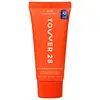What's inside
What's inside
 Key Ingredients
Key Ingredients

 Benefits
Benefits

 Concerns
Concerns

 Ingredients Side-by-side
Ingredients Side-by-side

Water
Skin ConditioningGlycerin
HumectantCetyl Ethylhexanoate
EmollientCaprylic/Capric Triglyceride
MaskingPropanediol
Solvent1,2-Hexanediol
Skin ConditioningGlyceryl Stearate
EmollientCetearyl Alcohol
EmollientMicrocrystalline Cellulose
AbsorbentSodium Polyacrylate Starch
AbsorbentSclerotium Gum
Emulsion StabilisingTriolein
Skin ConditioningPotassium Cetyl Phosphate
EmulsifyingBehenyl Alcohol
EmollientAllantoin
Skin ConditioningCeramide NP
Skin ConditioningGlyceryl Dioleate
EmollientCellulose Gum
Emulsion StabilisingSodium Phytate
Pentylene Glycol
Skin ConditioningSodium Acetylated Hyaluronate
HumectantSodium Hyaluronate
HumectantSodium Hyaluronate Crosspolymer
HumectantHydrolyzed Sodium Hyaluronate
Skin ConditioningEthylhexylglycerin
Skin ConditioningWater, Glycerin, Cetyl Ethylhexanoate, Caprylic/Capric Triglyceride, Propanediol, 1,2-Hexanediol, Glyceryl Stearate, Cetearyl Alcohol, Microcrystalline Cellulose, Sodium Polyacrylate Starch, Sclerotium Gum, Triolein, Potassium Cetyl Phosphate, Behenyl Alcohol, Allantoin, Ceramide NP, Glyceryl Dioleate, Cellulose Gum, Sodium Phytate, Pentylene Glycol, Sodium Acetylated Hyaluronate, Sodium Hyaluronate, Sodium Hyaluronate Crosspolymer, Hydrolyzed Sodium Hyaluronate, Ethylhexylglycerin
Water
Skin ConditioningCarthamus Tinctorius Seed Oil
MaskingCaprylic/Capric Triglyceride
MaskingGlycerin
HumectantC10-18 Triglycerides
EmollientRicinus Communis Seed Oil
MaskingCetearyl Alcohol
EmollientGlyceryl Stearate Citrate
EmollientRubus Chamaemorus Seed Oil
Skin ConditioningUbiquinone
AntioxidantCopper Tripeptide-1
Skin ConditioningPalmitoyl Tripeptide-5
Skin ConditioningHyaluronic Acid
HumectantBisabolol
MaskingZingiber Officinale Root Extract
MaskingChenopodium Quinoa Seed Extract
Skin ConditioningMannose
HumectantSodium Mannose Phosphate
HumectantDaucus Carota Sativa Root Extract
Skin ConditioningGlycine Max Seed Extract
Skin ConditioningOryza Sativa Extract
AbsorbentSaccharide Isomerate
HumectantPanax Ginseng Root Extract
EmollientTrisodium Ethylenediamine Disuccinate
Copernicia Cerifera Cera
EmollientCoco-Caprylate/Caprate
EmollientSorbitan Isostearate
EmulsifyingRhizobian Gum
Butylene Glycol
HumectantC9-12 Alkane
SolventHydroxyethyl Acrylate/Sodium Acryloyldimethyl Taurate Copolymer
Emulsion StabilisingCetyl Alcohol
EmollientGlyceryl Caprylate
Emollient1,2-Hexanediol
Skin ConditioningHydrogenated Castor Oil
EmollientSodium Citrate
BufferingXanthan Gum
EmulsifyingCetearyl Glucoside
EmulsifyingAcacia Senegal Gum
MaskingCitric Acid
BufferingEthylhexylglycerin
Skin ConditioningPhenoxyethanol
PreservativeParfum
MaskingWater, Carthamus Tinctorius Seed Oil, Caprylic/Capric Triglyceride, Glycerin, C10-18 Triglycerides, Ricinus Communis Seed Oil, Cetearyl Alcohol, Glyceryl Stearate Citrate, Rubus Chamaemorus Seed Oil, Ubiquinone, Copper Tripeptide-1, Palmitoyl Tripeptide-5, Hyaluronic Acid, Bisabolol, Zingiber Officinale Root Extract, Chenopodium Quinoa Seed Extract, Mannose, Sodium Mannose Phosphate, Daucus Carota Sativa Root Extract, Glycine Max Seed Extract, Oryza Sativa Extract, Saccharide Isomerate, Panax Ginseng Root Extract, Trisodium Ethylenediamine Disuccinate, Copernicia Cerifera Cera, Coco-Caprylate/Caprate, Sorbitan Isostearate, Rhizobian Gum, Butylene Glycol, C9-12 Alkane, Hydroxyethyl Acrylate/Sodium Acryloyldimethyl Taurate Copolymer, Cetyl Alcohol, Glyceryl Caprylate, 1,2-Hexanediol, Hydrogenated Castor Oil, Sodium Citrate, Xanthan Gum, Cetearyl Glucoside, Acacia Senegal Gum, Citric Acid, Ethylhexylglycerin, Phenoxyethanol, Parfum
 Reviews
Reviews

Ingredients Explained
These ingredients are found in both products.
Ingredients higher up in an ingredient list are typically present in a larger amount.
1,2-Hexanediol is a synthetic liquid and another multi-functional powerhouse.
It is a:
- Humectant, drawing moisture into the skin
- Emollient, helping to soften skin
- Solvent, dispersing and stabilizing formulas
- Preservative booster, enhancing the antimicrobial activity of other preservatives
This ingredient is an emollient, solvent, and texture enhancer. It is considered a skin-softener by helping the skin prevent moisture loss.
It helps thicken a product's formula and makes it easier to spread by dissolving clumping compounds.
Caprylic Triglyceride is made by combining glycerin with coconut oil, forming a clear liquid.
While there is an assumption Caprylic Triglyceride can clog pores due to it being derived from coconut oil, there is no research supporting this.
Learn more about Caprylic/Capric TriglycerideCetearyl alcohol is a mixture of two fatty alcohols: cetyl alcohol and stearyl alcohol. It is mainly used as an emulsifier. Emulsifiers help prevent the separation of oils and products. Due to its composition, it can also be used to thicken a product or help create foam.
Cetearyl alcohol is an emollient. Emollients help soothe and hydrate the skin by trapping moisture.
Studies show Cetearyl alcohol is non-toxic and non-irritating. The FDA allows products labeled "alcohol-free" to have fatty alcohols.
This ingredient is usually derived from plant oils such as palm, vegetable, or coconut oils. There is debate on whether this ingredient will cause acne.
Due to the fatty acid base, this ingredient may not be Malassezia folliculitis safe.
Learn more about Cetearyl AlcoholEthylhexylglycerin (we can't pronounce this either) is commonly used as a preservative and skin softener. It is derived from glyceryl.
You might see Ethylhexylglycerin often paired with other preservatives such as phenoxyethanol. Ethylhexylglycerin has been found to increase the effectiveness of these other preservatives.
Glycerin is already naturally found in your skin. It helps moisturize and protect your skin.
A study from 2016 found glycerin to be more effective as a humectant than AHAs and hyaluronic acid.
As a humectant, it helps the skin stay hydrated by pulling moisture to your skin. The low molecular weight of glycerin allows it to pull moisture into the deeper layers of your skin.
Hydrated skin improves your skin barrier; Your skin barrier helps protect against irritants and bacteria.
Glycerin has also been found to have antimicrobial and antiviral properties. Due to these properties, glycerin is often used in wound and burn treatments.
In cosmetics, glycerin is usually derived from plants such as soybean or palm. However, it can also be sourced from animals, such as tallow or animal fat.
This ingredient is organic, colorless, odorless, and non-toxic.
Glycerin is the name for this ingredient in American English. British English uses Glycerol/Glycerine.
Learn more about GlycerinWater. It's the most common cosmetic ingredient of all. You'll usually see it at the top of ingredient lists, meaning that it makes up the largest part of the product.
So why is it so popular? Water most often acts as a solvent - this means that it helps dissolve other ingredients into the formulation.
You'll also recognize water as that liquid we all need to stay alive. If you see this, drink a glass of water. Stay hydrated!
Learn more about Water